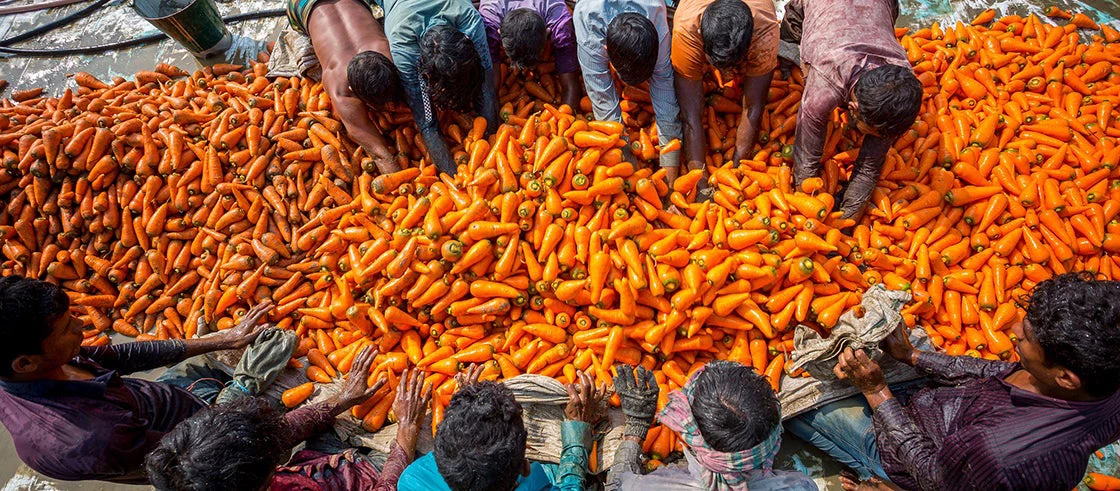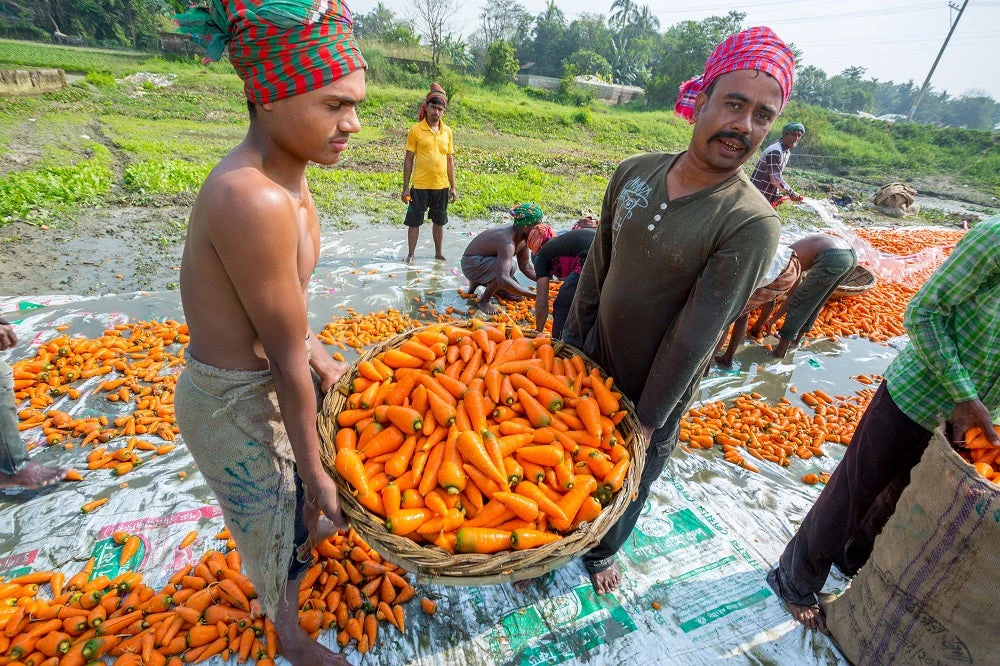 Farmers wash carrots after harvest in Dhaka, Bangladesh. Photo: Jahangir Alam Onuchcha / Shutterstock.com
Farmers wash carrots after harvest in Dhaka, Bangladesh. Photo: Jahangir Alam Onuchcha / Shutterstock.com
When Anushree Shridhar heard that vegetables and fruits were rotting in fields near Bengaluru because of India’s COVID-19 lockdown, she knew she had to do something to connect farmers and hungry families.
Anushree, a senior accounting assistant with the World Bank’s Chennai office, helped family and friends collect enough money to buy 10 tons of fresh produce from about 250 farmers. Using masks and gloves, the volunteers delivered free, nutritious food to a dozen settlements where poor families are struggling to survive. “This is a win-win,” she said. “Farmers get a reasonable price for their crops and the needy get to fill their stomachs.”
Anushree and others worry that the loss of jobs due to COVID-19 will reverse hard-fought gains to improve nutrition – and the overall health – of children and women throughout South Asia.
The region still accounts for about 40 percent of the world’s stunted children, which means they are too short for their age, usually from malnutrition. Stunting affects brain development and has a lifelong impact. Similarly, women in South Asia have some of the world’s highest rates of anemia, an iron deficiency.
South Asia still accounts for about 40% of the world’s stunted children, which means they are too short for their age, usually from malnutrition.
As the World Bank and other development partners address pandemic-related food security in the region, this is a good time to revisit important lessons learned from our South Asia Food and Nutrition Security Initiative (SAFANSI), particularly for vulnerable groups such as women and children. The initiative piloted innovative ideas and filled critical knowledge gaps about malnutrition and food security. With support from the United Kingdom, Australia, and the European Commission, SAFANSI provided $24.2 million to finance more than 100 activities.
SAFANSI focused on improving the micro- and macro-nutrient content of food needed for good health, rather than sufficient caloric intake alone. It examined reasons behind the region’s sharp disparities in the nutrition status of men and women. The program also developed packages of interventions to help poor households by combining expertise in agriculture, health, education, water supply, sanitation, and social safety nets.
Below are some of SAFANSI’s findings that can help guide recovery efforts in South Asia over the coming months, especially for the vulnerable population.
1. A SAFANSI-funded research study, The Nutrition Sensitivity of Food and Agriculture in South Asia, identified a set of complex relationships underlying malnutrition. Social safety nets, including food transfer programs, can help the most vulnerable households cope with food shortages and rising prices, though transfers may be too small to support long-term improvements in nutrition and health. Investments in home gardens and livestock can help households weather future crises by providing access to nutritious vegetables, eggs, and milk.

2. Another study, The Cost of a Nutritious Diet in Afghanistan, Bangladesh, Pakistan, and Sri Lanka, suggests that consumers in these countries should spend more of their food budget on perishables such as dairy and vegetables. The average household here consumes enough cereals and starchy staples but lacks a sufficient quantity of vegetables, which often have more variable prices. Trade disruptions related to COVID-19 are constraining supply chains and could lead to higher prices for perishable foods, exacerbating these deficiencies.
3. A further study, Gender-Inclusive Nutrition Activities in South Asia, examined why gender is a key factor in the region’s malnutrition rates. It found that efforts to improve nutrition should go beyond a mother’s cooking knowledge and include social factors such as her household and community support, and her control over household spending. Additionally, adolescent girls are too often ignored by existing programs despite high rates of undernutrition and pregnancies at a young age.
4. A Bangladesh conditional cash transfer pilot program that paid poor households an average of $5-10 per month reduced wasting in children under two. An evaluation concluded that the combination of cash, nutrition education, and growth monitoring motivated mothers to feed their children more nutritious food.
5. In India, half of all children are deficient in Vitamin A. Among children under five years old, 70 percent lack enough vitamin D. A pilot program supported by Tata Trusts, dairy producers, and state-level milk federations added vitamins A and D to milk. One glass of fortified milk (320 grams) provides about one-third of the vitamin A and nearly half of the vitamin D recommended for daily consumption. SAFANSI worked with partners behind the scenes to help establish regulatory standards for fortifying whole, low-fat, and skim milk.
Although there has been progress, food security and malnutrition remain a huge challenge for South Asia.
6. In Bhutan, a national nutrition assessment worked with a range of stakeholders to identify factors in malnutrition. The study, described here, informed the government’s five-year plan for 2013-18. It found key causes of stunting were women’s poor nutrition and health care before and during pregnancy. Other factors included Bhutan’s dependence on food imports and vulnerability to world price fluctuations, as well as cultural and ethnic influences on feeding practices.
7. Pakistan has succeeded in producing more food, but the country’s poorest and most vulnerable often cannot afford a sufficient and nutritious diet. Even some households classified as food secure may have some members suffering from malnutrition because of how food is distributed. After the central government delegated nutrition issues to provincial governments, SAFANSI helped develop nutrition policy guidance notes in four provinces that stressed multisectoral coordination with a focus on water supply and hygiene, food security, health care services, girls’ education, and social safety nets.
Although there has been progress, food security and malnutrition remain a huge challenge for South Asia. Hence the World Bank is prioritizing food security in the region's COVID-19 response. This entails maintaining domestic production, keeping borders open, minimizing disruptions to supply chains, and strengthening global cooperation to secure food. It is also essential to focus on the needs of the most vulnerable and ensure that food is not only plentiful, but also nutritious. SAFANSI teaches a number of effective ways to do this such as focusing on nutrient-dense foods, combining social safety net programs with nutrition education, and tailoring interventions for pregnant and nursing women, young children, and adolescent females.



Join the Conversation